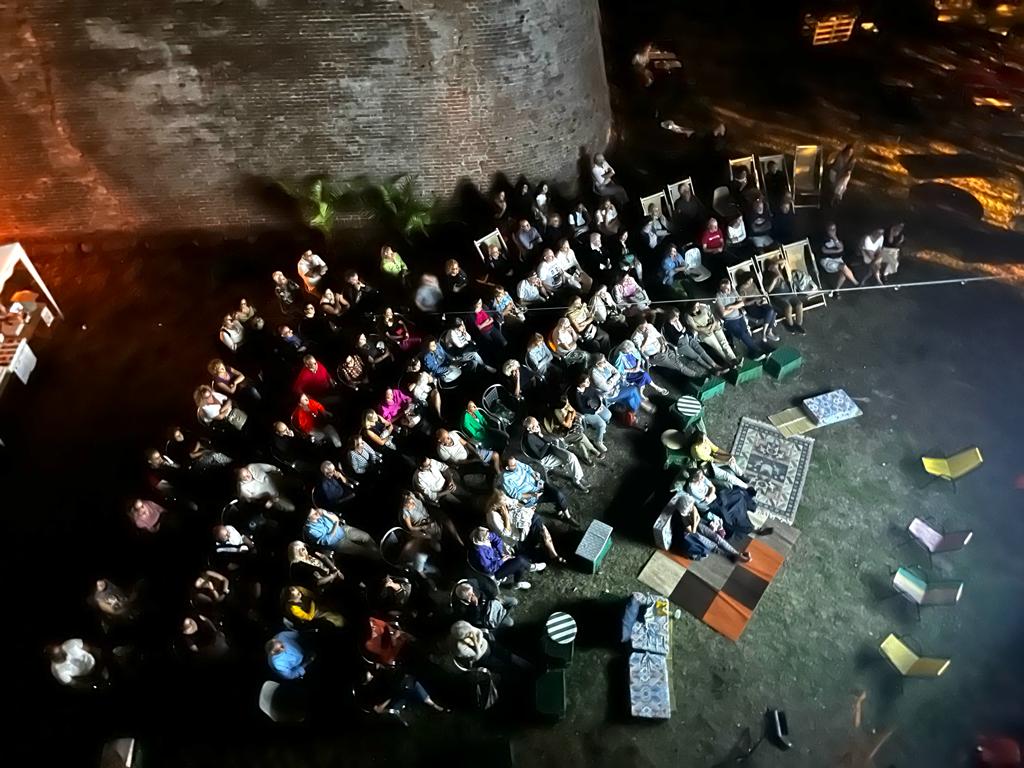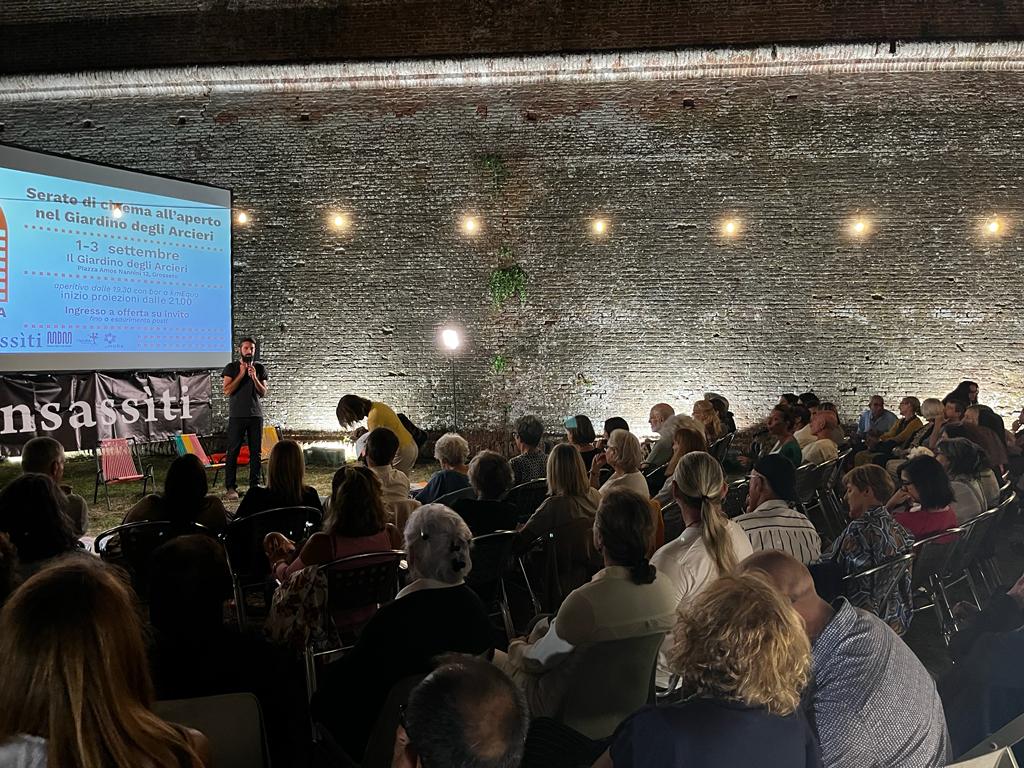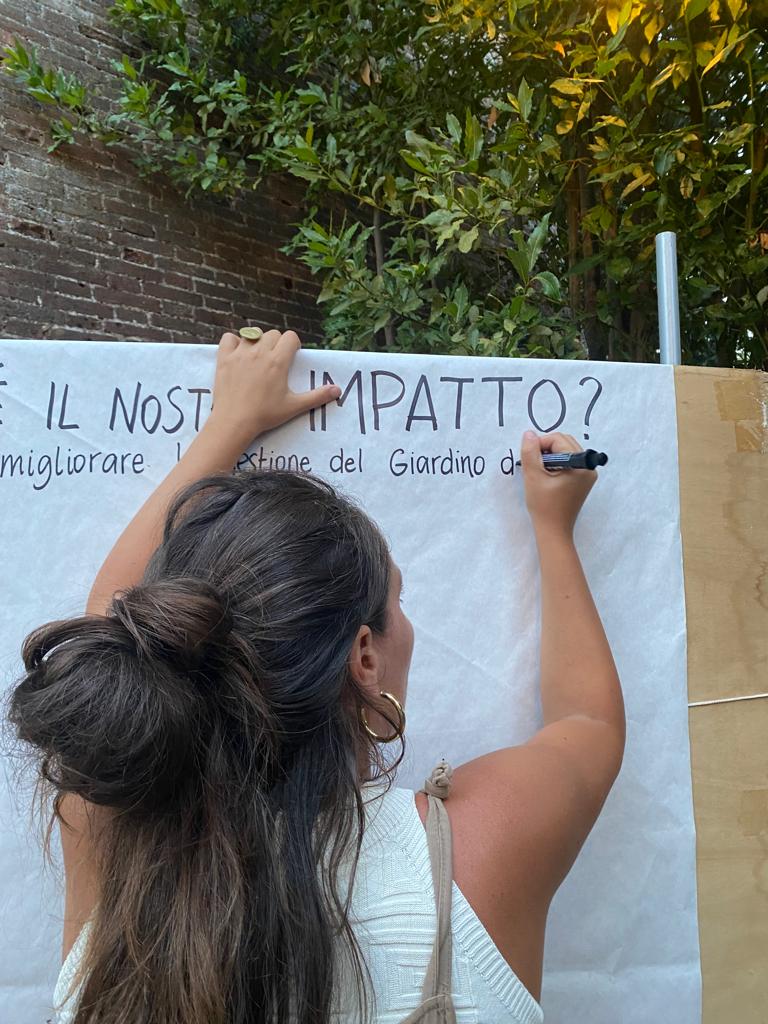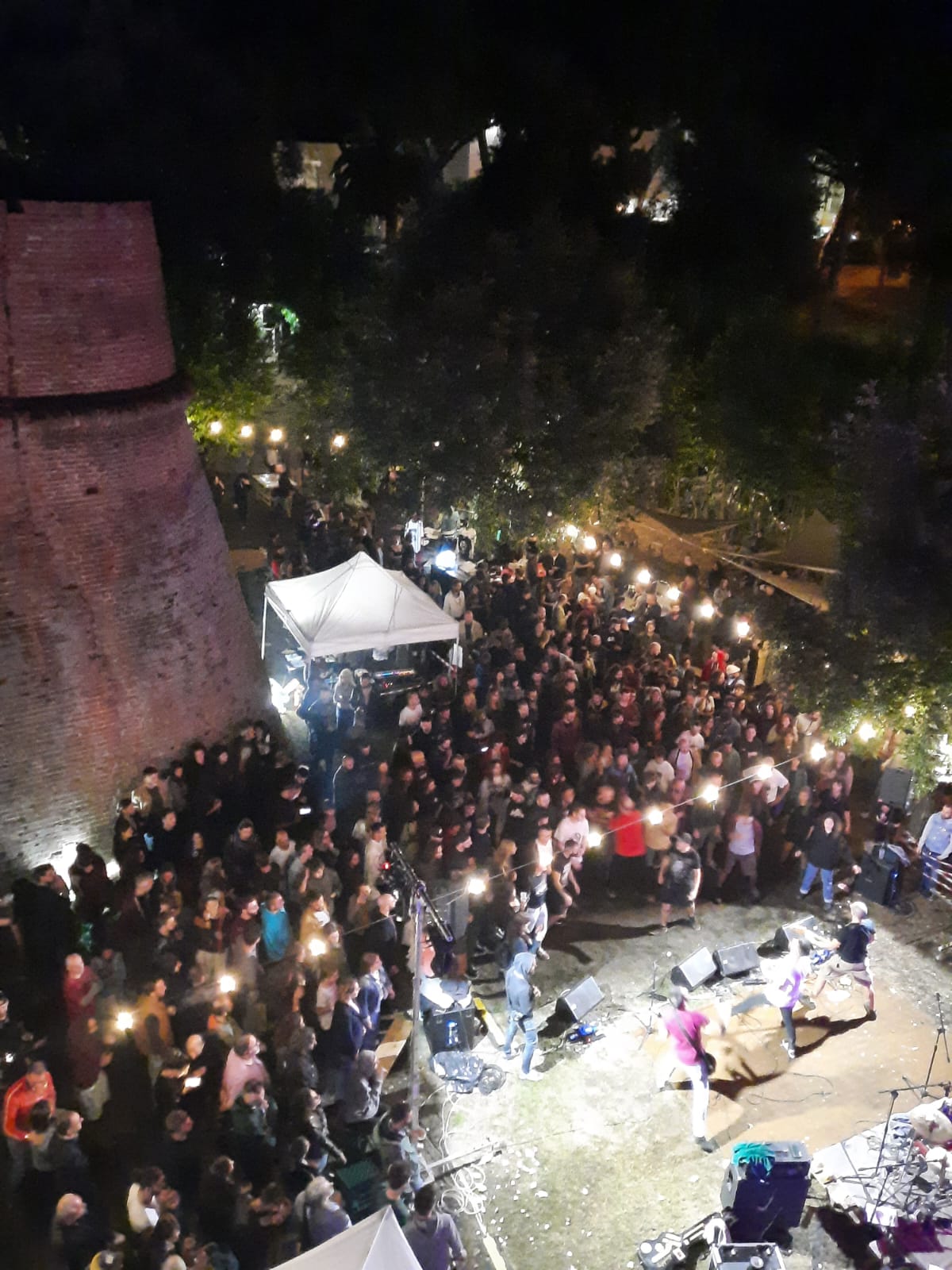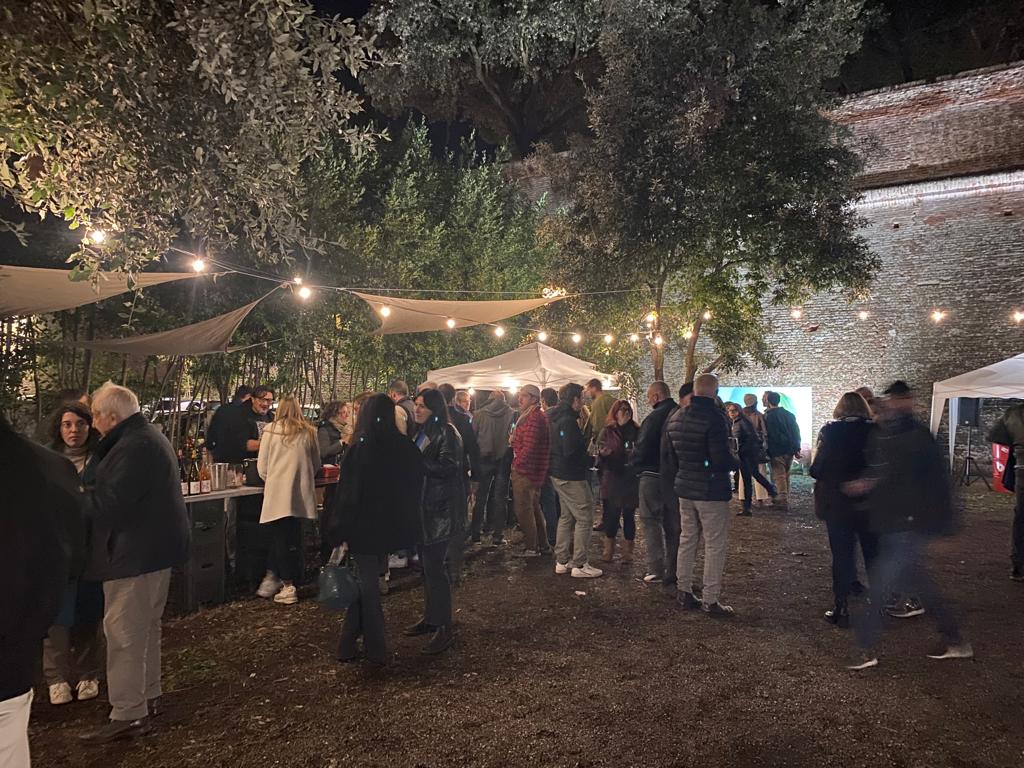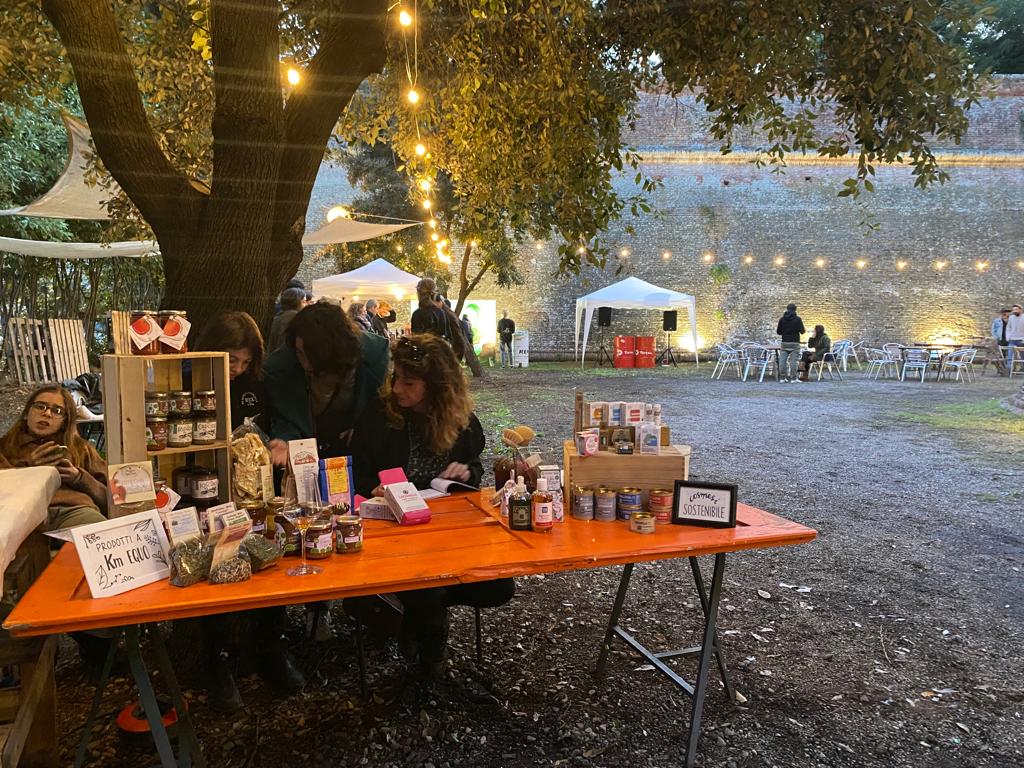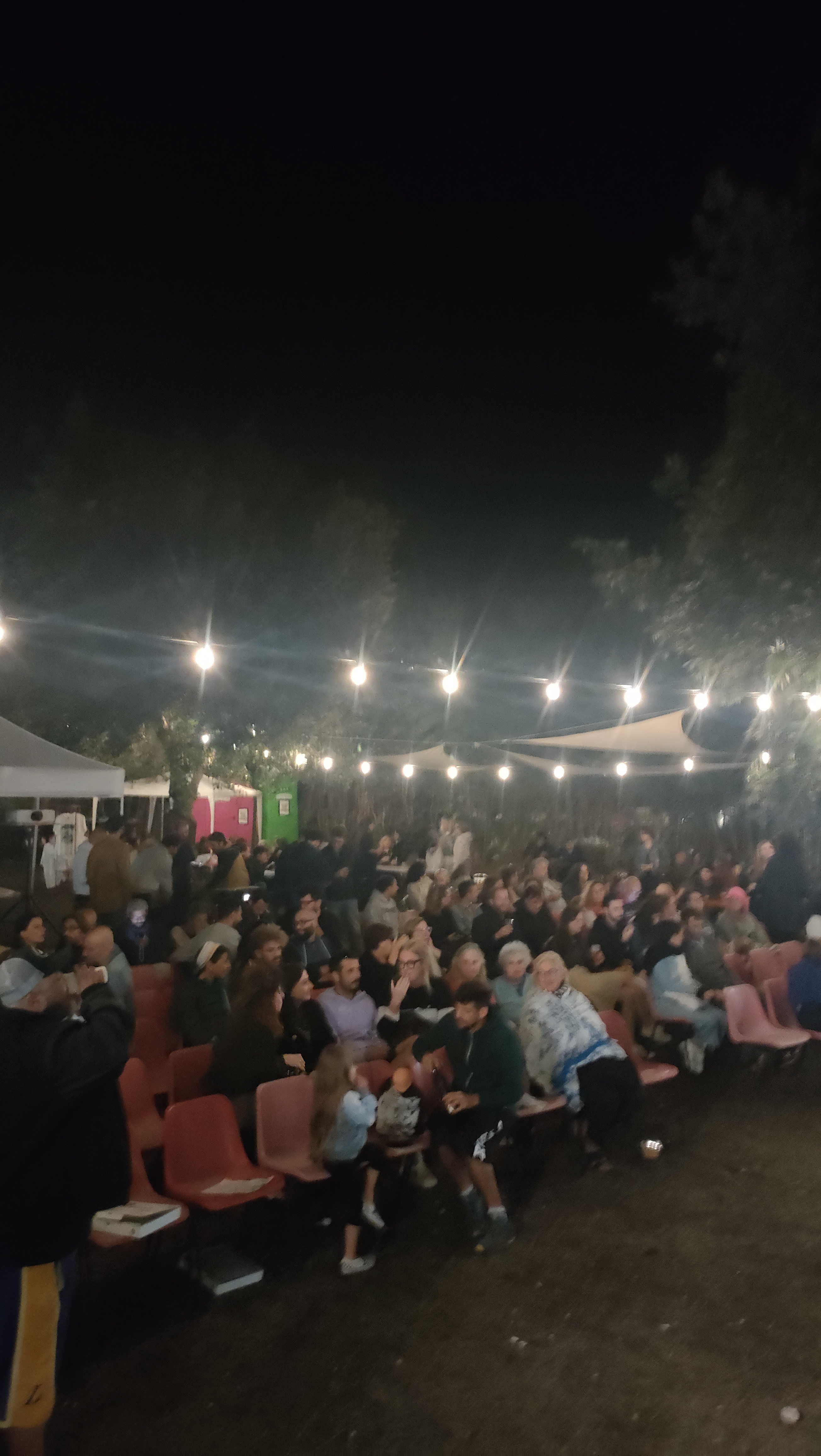Regaining a sense of belonging
Giardino
Giardino: Community-Driven Regeneration of Il Giardino degli Arcieri in Grosseto
A vibrant community initiative to transform Il Giardino degli Arcieri in Grosseto into a lively, sustainable, and inclusive space. Through collaboration and co-creation, the project blends history, culture, and innovation to foster connections, inspire creativity, and celebrate the city's heritage while building a greener, more united future. Join us in shaping a shared vision for this unique urban garden!
Italy
Local
The project is implemented at the local level and covers the province of Grosseto, Italy.
It addresses urban-rural linkages
It refers to a physical transformation of the built environment (hard investment)
Yes
2024-04-28
No
No
No
As a representative of an organisation
Giardino is a community-driven urban regeneration project transforming Il Giardino degli Arcieri in Grosseto into a sustainable, inclusive, and vibrant public space.
The project engages young local residents, artists, designers, planners, students, and stakeholders, all committed to fostering urban transformation and economic revitalization. Its main objectives include regenerating Il Giardino degli Arcieri, creating a multifunctional hub that blends history and innovation, engaging the community in co-design workshops to ensure a bottom-up approach and promoting cultural heritage through art, exhibitions, and educational programs. Additionally, it aims to implement sustainable solutions, such as urban gardening and circular economy projects, and to strengthen governance through public-private partnerships for long-term sustainability.
The project has already achieved significant outcomes. More than 20 participants have actively contributed to the co-design process. A shared vision has been developed through workshops and meetings. The planned transformation includes spaces for cultural events, co-working areas, and urban gardens. Collaboration with the municipality is ongoing to integrate the project into Grosseto’s urban development strategy. Being part of the New European Bauhaus initiative, ReGenea: Giardino is positioned as a scalable and replicable model for sustainable urban regeneration.
This project showcases the power of community-led urban transformation, creating a sustainable and inclusive future for Grosseto.
The project engages young local residents, artists, designers, planners, students, and stakeholders, all committed to fostering urban transformation and economic revitalization. Its main objectives include regenerating Il Giardino degli Arcieri, creating a multifunctional hub that blends history and innovation, engaging the community in co-design workshops to ensure a bottom-up approach and promoting cultural heritage through art, exhibitions, and educational programs. Additionally, it aims to implement sustainable solutions, such as urban gardening and circular economy projects, and to strengthen governance through public-private partnerships for long-term sustainability.
The project has already achieved significant outcomes. More than 20 participants have actively contributed to the co-design process. A shared vision has been developed through workshops and meetings. The planned transformation includes spaces for cultural events, co-working areas, and urban gardens. Collaboration with the municipality is ongoing to integrate the project into Grosseto’s urban development strategy. Being part of the New European Bauhaus initiative, ReGenea: Giardino is positioned as a scalable and replicable model for sustainable urban regeneration.
This project showcases the power of community-led urban transformation, creating a sustainable and inclusive future for Grosseto.
Sustainability
Inclusion
Community
Heritage
Innovation
Giardino integrates sustainability at its core, aiming to regenerate Il Giardino degli Arcieri through environmentally responsible solutions while fostering social inclusion and economic resilience. The project prioritizes green infrastructure, resource efficiency, and community participation in order to create a long-term impact.
A key objective is the ecological regeneration of the space, incorporating native plants, urban gardening, and green areas to sustain biodiversity and air quality. The project promotes a circular economy approach by encouraging upcycling and sustainable materials in construction and maintenance..
Social sustainability is ensured by engaging the local community in the co-design and management of the space, reinforcing a sense of ownership and long-term care. The project also supports economic sustainability through the creation of co-working spaces, workshops, and cultural events that generate opportunities for local artists, entrepreneurs, and social enterprises.
ReGenea: Giardino serves as an exemplary model by demonstrating how heritage sites can be repurposed through a participatory, eco-conscious approach. Its replicability in other urban areas, combined with strong collaboration with public institutions and local stakeholders, showcases a scalable and impactful strategy for sustainable urban development.
A key objective is the ecological regeneration of the space, incorporating native plants, urban gardening, and green areas to sustain biodiversity and air quality. The project promotes a circular economy approach by encouraging upcycling and sustainable materials in construction and maintenance..
Social sustainability is ensured by engaging the local community in the co-design and management of the space, reinforcing a sense of ownership and long-term care. The project also supports economic sustainability through the creation of co-working spaces, workshops, and cultural events that generate opportunities for local artists, entrepreneurs, and social enterprises.
ReGenea: Giardino serves as an exemplary model by demonstrating how heritage sites can be repurposed through a participatory, eco-conscious approach. Its replicability in other urban areas, combined with strong collaboration with public institutions and local stakeholders, showcases a scalable and impactful strategy for sustainable urban development.
Giardino redefines an abandoned and neglected space, previously perceived as unsafe and disconnected from the city, into a functional and welcoming urban environment. The project enhances the historical identity of Il Giardino degli Arcieri while integrating contemporary elements that encourage accessibility, cultural engagement, and social interaction.
A key objective is to restore a sense of place through thoughtful design that balances preservation and renewal. The intervention introduces green areas, open spaces, and adaptable structures, making the site both aesthetically pleasing and practical for everyday use. Sustainable materials and nature-based solutions ensure durability and environmental harmony.
The transformation prioritizes people’s experience by creating a space that fosters community interaction and cultural participation. The site hosts art installations, performances, and public events, turning it into a vibrant meeting point. Co-designed with local residents, it responds to real needs, making it accessible and inclusive for all age groups.
ReGenea: Giardino serves as a replicable model for urban regeneration, demonstrating how neglected areas can be reclaimed through participatory planning. By addressing both spatial and social fragmentation, the project proves that historical sites can become dynamic and functional places, fostering community well-being and strengthening urban identity.
A key objective is to restore a sense of place through thoughtful design that balances preservation and renewal. The intervention introduces green areas, open spaces, and adaptable structures, making the site both aesthetically pleasing and practical for everyday use. Sustainable materials and nature-based solutions ensure durability and environmental harmony.
The transformation prioritizes people’s experience by creating a space that fosters community interaction and cultural participation. The site hosts art installations, performances, and public events, turning it into a vibrant meeting point. Co-designed with local residents, it responds to real needs, making it accessible and inclusive for all age groups.
ReGenea: Giardino serves as a replicable model for urban regeneration, demonstrating how neglected areas can be reclaimed through participatory planning. By addressing both spatial and social fragmentation, the project proves that historical sites can become dynamic and functional places, fostering community well-being and strengthening urban identity.
Our objectives are:
Universal Accessibility
We have removed physical barriers to ensure ease of movement for all, making Il Giardino fully accessible. The space has been designed to be adaptable and welcoming, prioritizing inclusivity for people with disabilities, the elderly, and those with mobility challenges. The design follows the "design for all" principles, ensuring that everyone can comfortably navigate and enjoy the space.
Affordability
To ensure financial inclusivity, we provide free or low-cost access to cultural events, workshops, and shared community spaces. We actively seek funding and sponsorships to maintain affordability, ensuring that economic barriers do not exclude anyone from participating. The project is rooted in the belief that culture and community spaces should be accessible to all, regardless of income.
Social Inclusion
Il Giardino degli Arcieri is a meeting place where people from diverse backgrounds can interact. Our cultural and artistic programming is intentionally varied, integrating different artistic traditions, cultural expressions, and personal perspectives. This allows individuals to bring their unique histories into the space and share them with the wider community, fostering deeper understanding and social cohesion.
Participatory Governance
Beyond community participation in design and decision-making, we maintain continuous dialogue with local institutions, schools, and third-sector organizations. By creating a stable and structured network, we enhance long-term sustainability and maximize the project's impact. This collaborative approach ensures that the space remains relevant and beneficial to the entire community.
Collective Ownership
This project belongs to everyone. We actively encourage individuals to contribute their personal stories and experiences to the space, reinforcing a sense of belonging. Grosseto, despite being a small city, is home to a diverse range of communities. Our goal is for Il Giardino
Universal Accessibility
We have removed physical barriers to ensure ease of movement for all, making Il Giardino fully accessible. The space has been designed to be adaptable and welcoming, prioritizing inclusivity for people with disabilities, the elderly, and those with mobility challenges. The design follows the "design for all" principles, ensuring that everyone can comfortably navigate and enjoy the space.
Affordability
To ensure financial inclusivity, we provide free or low-cost access to cultural events, workshops, and shared community spaces. We actively seek funding and sponsorships to maintain affordability, ensuring that economic barriers do not exclude anyone from participating. The project is rooted in the belief that culture and community spaces should be accessible to all, regardless of income.
Social Inclusion
Il Giardino degli Arcieri is a meeting place where people from diverse backgrounds can interact. Our cultural and artistic programming is intentionally varied, integrating different artistic traditions, cultural expressions, and personal perspectives. This allows individuals to bring their unique histories into the space and share them with the wider community, fostering deeper understanding and social cohesion.
Participatory Governance
Beyond community participation in design and decision-making, we maintain continuous dialogue with local institutions, schools, and third-sector organizations. By creating a stable and structured network, we enhance long-term sustainability and maximize the project's impact. This collaborative approach ensures that the space remains relevant and beneficial to the entire community.
Collective Ownership
This project belongs to everyone. We actively encourage individuals to contribute their personal stories and experiences to the space, reinforcing a sense of belonging. Grosseto, despite being a small city, is home to a diverse range of communities. Our goal is for Il Giardino
Local residents participated in co-design workshops, open meetings, and planning sessions, identifying priorities and shaping the project vision. Over 20 people were directly involved in structured workshops focused on stakeholder mapping and solution ideation. Citizens also contributed to the physical regeneration of the space through activities such as site cleanup, urban gardening, and artistic interventions, reinforcing a sense of ownership.
The Cooperativa di Comunità della Maremma Le Vie played a key role in coordinating participation, bringing together residents, associations, and social enterprises to integrate sustainability and inclusivity into the project. Collaboration with local authorities ensured institutional support and alignment with urban policies, overcoming bureaucratic challenges through transparent communication.
The success of the initiative is evident in the strong public response. Hundreds of people attended the cultural and recreational events organized in the regenerated space, demonstrating the community’s appreciation for this urban renewal effort. The introduction of innovative cultural programming and interactive activities, uncommon in the Grosseto context, has contributed to repositioning the area as a vibrant, inclusive meeting place.
The Cooperativa di Comunità della Maremma Le Vie played a key role in coordinating participation, bringing together residents, associations, and social enterprises to integrate sustainability and inclusivity into the project. Collaboration with local authorities ensured institutional support and alignment with urban policies, overcoming bureaucratic challenges through transparent communication.
The success of the initiative is evident in the strong public response. Hundreds of people attended the cultural and recreational events organized in the regenerated space, demonstrating the community’s appreciation for this urban renewal effort. The introduction of innovative cultural programming and interactive activities, uncommon in the Grosseto context, has contributed to repositioning the area as a vibrant, inclusive meeting place.
Giardino project is built on strong multi-level engagement to ensure participatory governance and lasting impact.
Local Level: We actively collaborate with the Municipality of Grosseto, specifically with the Councillor for Culture, to secure institutional support and integrate the project into the city’s cultural policies. Local schools participate through educational workshops, while the Le Vie Community Cooperative mobilizes associations and citizens via co-design sessions, fostering a strong sense of ownership.
Regional Level: The Tuscany Region has facilitated connections with urban regeneration and social innovation programs. Additionally, we collaborate with cultural and environmental organizations to strengthen the project’s sustainability. Local businesses have supported the initiative by providing materials and services at favorable conditions.
National Level: The Le Vie association maintains partnerships with similar projects in Bologna, Rome, and Milan, enabling the exchange of best practices on participatory management and cultural innovation. Furthermore, funding from the Robert Bosch Foundation through ICLEI Europe has provided crucial financial resources for the project's launch and long-term viability.
European Level: ReGenea: Giardino is part of the New European Bauhaus, benefiting from a European network of urban regeneration projects, increased visibility, and potential EU funding to expand and strengthen the initiative.
Local Level: We actively collaborate with the Municipality of Grosseto, specifically with the Councillor for Culture, to secure institutional support and integrate the project into the city’s cultural policies. Local schools participate through educational workshops, while the Le Vie Community Cooperative mobilizes associations and citizens via co-design sessions, fostering a strong sense of ownership.
Regional Level: The Tuscany Region has facilitated connections with urban regeneration and social innovation programs. Additionally, we collaborate with cultural and environmental organizations to strengthen the project’s sustainability. Local businesses have supported the initiative by providing materials and services at favorable conditions.
National Level: The Le Vie association maintains partnerships with similar projects in Bologna, Rome, and Milan, enabling the exchange of best practices on participatory management and cultural innovation. Furthermore, funding from the Robert Bosch Foundation through ICLEI Europe has provided crucial financial resources for the project's launch and long-term viability.
European Level: ReGenea: Giardino is part of the New European Bauhaus, benefiting from a European network of urban regeneration projects, increased visibility, and potential EU funding to expand and strengthen the initiative.
Giardino project integrates multiple disciplines.
Urban planning and architecture guided the regeneration of Il Giardino degli Arcieri, ensuring accessibility and respect for historical heritage. Environmental sustainability experts contributed to urban gardening and eco-friendly solutions to enhance biodiversity. Cultural heritage and arts played a key role in reconnecting the community with the Bastion of the Medicean Walls through artistic and cultural events.
Social sciences and community engagement were essential, with public workshops and co-design processes involving residents, schools, and associations. The Le Vie cooperative facilitated a governance model based on active participation. Social economy and financial sustainability ensured the project's resilience, supported by the Robert Bosch Foundation through ICLEI Europe, as well as partnerships with local businesses and cultural organizations.
Collaboration between architects and sustainability experts helped integrate environmental solutions into the design. Historians and cultural curators worked with artists to create inclusive programming. Social economy specialists partnered with institutions to develop sustainable funding models. Schools and community groups actively shaped the project, making it relevant to local needs.
This interdisciplinary approach strengthened urban regeneration, community participation, and economic resilience, making ReGenea: Giardino a replicable model for inclusive and sustainable public space management.
Urban planning and architecture guided the regeneration of Il Giardino degli Arcieri, ensuring accessibility and respect for historical heritage. Environmental sustainability experts contributed to urban gardening and eco-friendly solutions to enhance biodiversity. Cultural heritage and arts played a key role in reconnecting the community with the Bastion of the Medicean Walls through artistic and cultural events.
Social sciences and community engagement were essential, with public workshops and co-design processes involving residents, schools, and associations. The Le Vie cooperative facilitated a governance model based on active participation. Social economy and financial sustainability ensured the project's resilience, supported by the Robert Bosch Foundation through ICLEI Europe, as well as partnerships with local businesses and cultural organizations.
Collaboration between architects and sustainability experts helped integrate environmental solutions into the design. Historians and cultural curators worked with artists to create inclusive programming. Social economy specialists partnered with institutions to develop sustainable funding models. Schools and community groups actively shaped the project, making it relevant to local needs.
This interdisciplinary approach strengthened urban regeneration, community participation, and economic resilience, making ReGenea: Giardino a replicable model for inclusive and sustainable public space management.
Giardino project introduces an innovative, bottom-up approach to urban regeneration, moving beyond traditional top-down planning. Its uniqueness lies in its hybrid model, where urban space is not only rehabilitated but actively shaped and managed by the community through a structured participatory process.
Unlike standard regeneration projects that prioritize either infrastructure or aesthetics, ReGenea: Giardino integrates social, environmental, and cultural innovation. It transforms a neglected space into a multi-purpose hub, where heritage conservation, ecological sustainability, and social inclusion coexist.
A key innovation is its participatory governance model, which fosters long-term engagement by actively involving residents, schools, and local organizations in both decision-making and space management. This contrasts with conventional projects where public participation is often limited to initial consultations.
Additionally, the project moves beyond traditional ecological interventions by applying circular economy principles. Instead of simply adding green elements, it promotes community-driven maintenance, resource-sharing, and economic sustainability through local partnerships.
By leveraging regional, national, and European networks, including the New European Bauhaus, the project ensures replicability and scalability. This strategic alignment provides visibility and access to funding, making ReGenea: Giardino a model for adaptable, community-led urban transformation, setting it apart from mainstream approaches.
Unlike standard regeneration projects that prioritize either infrastructure or aesthetics, ReGenea: Giardino integrates social, environmental, and cultural innovation. It transforms a neglected space into a multi-purpose hub, where heritage conservation, ecological sustainability, and social inclusion coexist.
A key innovation is its participatory governance model, which fosters long-term engagement by actively involving residents, schools, and local organizations in both decision-making and space management. This contrasts with conventional projects where public participation is often limited to initial consultations.
Additionally, the project moves beyond traditional ecological interventions by applying circular economy principles. Instead of simply adding green elements, it promotes community-driven maintenance, resource-sharing, and economic sustainability through local partnerships.
By leveraging regional, national, and European networks, including the New European Bauhaus, the project ensures replicability and scalability. This strategic alignment provides visibility and access to funding, making ReGenea: Giardino a model for adaptable, community-led urban transformation, setting it apart from mainstream approaches.
1)Participatory Co-Design & Governance
The project is based on active citizen involvement, where residents, local organizations, and institutions co-design the space through workshops and consultations.
Unlike conventional urban projects, governance is shared, allowing continuous public participation in decision-making and management.
2)Step-by-Step Regeneration Process
The intervention follows a phased approach:
Community Mapping & Needs Assessment: Identifying local needs through surveys and stakeholder engagement.
Co-Design Workshops: Residents and experts collaborate to shape the space.
Pilot Actions & Testing: Small-scale interventions are tested before full implementation.
Implementation & Adaptive Management: The space evolves based on community feedback.
3)Sustainability & Circular Economy Model
The project integrates eco-friendly solutions such as urban gardens and responsible water management.
A circular economy approach ensures long-term viability, engaging local businesses and promoting self-sustaining maintenance models.
4)Multi-Level Networking & Scalability
The project benefits from local, national, and European partnerships, ensuring best practice exchange and potential replication.
Alignment with New European Bauhaus principles reinforces its adaptability and visibility.
Outcome: This bottom-up, inclusive, and adaptive methodology ensures that ReGenea: Giardino remains a living, evolving space, deeply embedded in the local community while offering a replicable model for urban regeneration elsewhere.
The project is based on active citizen involvement, where residents, local organizations, and institutions co-design the space through workshops and consultations.
Unlike conventional urban projects, governance is shared, allowing continuous public participation in decision-making and management.
2)Step-by-Step Regeneration Process
The intervention follows a phased approach:
Community Mapping & Needs Assessment: Identifying local needs through surveys and stakeholder engagement.
Co-Design Workshops: Residents and experts collaborate to shape the space.
Pilot Actions & Testing: Small-scale interventions are tested before full implementation.
Implementation & Adaptive Management: The space evolves based on community feedback.
3)Sustainability & Circular Economy Model
The project integrates eco-friendly solutions such as urban gardens and responsible water management.
A circular economy approach ensures long-term viability, engaging local businesses and promoting self-sustaining maintenance models.
4)Multi-Level Networking & Scalability
The project benefits from local, national, and European partnerships, ensuring best practice exchange and potential replication.
Alignment with New European Bauhaus principles reinforces its adaptability and visibility.
Outcome: This bottom-up, inclusive, and adaptive methodology ensures that ReGenea: Giardino remains a living, evolving space, deeply embedded in the local community while offering a replicable model for urban regeneration elsewhere.
The project incorporates several key elements that can be replicated or transferred to different locations, beneficiary groups, and contexts.
Community Engagement and Co-Design
A participatory approach involving residents, businesses, artists, and activists in shaping the project.
Open meetings and workshops to gather ideas and define the shared vision.
A structured selection process ensuring diversity and interdisciplinarity among participants.
Urban Regeneration and Sustainability
Transformation of a neglected historical site into a multifunctional space integrating culture, history, and community needs.
Creation of a vibrant hub fostering social inclusion, sustainability, and cultural activities.
Incorporation of eco-friendly practices, including urban gardens and nature-based solutions.
Economic and Social Sustainability
Public-private partnership models for shared management of historical and cultural assets.
Social financing tools, including solidarity bonds to engage private investors.
Promotion of local development through cultural and community-driven economic activities.
Educational and Cultural Programs
Workshops and training sessions on urban sustainability, historical preservation, and participatory design.
Cultural and artistic events fostering community engagement and shared identity.
Interactive exhibitions and educational initiatives to reconnect people with their heritage.
Transferability and Scalability
The model is adaptable to different urban and rural settings, from small villages to larger metropolitan areas.
Its interdisciplinary and collaborative approach makes it applicable across various cultural and socio-economic contexts.
Engagement with European networks, such as the New European Bauhaus, enhances the project's transferability.
Community Engagement and Co-Design
A participatory approach involving residents, businesses, artists, and activists in shaping the project.
Open meetings and workshops to gather ideas and define the shared vision.
A structured selection process ensuring diversity and interdisciplinarity among participants.
Urban Regeneration and Sustainability
Transformation of a neglected historical site into a multifunctional space integrating culture, history, and community needs.
Creation of a vibrant hub fostering social inclusion, sustainability, and cultural activities.
Incorporation of eco-friendly practices, including urban gardens and nature-based solutions.
Economic and Social Sustainability
Public-private partnership models for shared management of historical and cultural assets.
Social financing tools, including solidarity bonds to engage private investors.
Promotion of local development through cultural and community-driven economic activities.
Educational and Cultural Programs
Workshops and training sessions on urban sustainability, historical preservation, and participatory design.
Cultural and artistic events fostering community engagement and shared identity.
Interactive exhibitions and educational initiatives to reconnect people with their heritage.
Transferability and Scalability
The model is adaptable to different urban and rural settings, from small villages to larger metropolitan areas.
Its interdisciplinary and collaborative approach makes it applicable across various cultural and socio-economic contexts.
Engagement with European networks, such as the New European Bauhaus, enhances the project's transferability.
The project addresses climate change by promoting urban greening, repurposing abandoned spaces with sustainable landscaping, and integrating nature-based solutions. It fosters environmental awareness and biodiversity conservation while supporting climate adaptation.
Social fragmentation and the lack of inclusive public spaces are tackled through participatory processes that encourage engagement. The project combats isolation by creating accessible spaces for interaction, cultural activities, and collaboration, reinforcing social cohesion and a sense of belonging. It ensures that historically significant sites remain active and beneficial to all members of society.
Urbanization and the loss of cultural identity are mitigated by integrating heritage preservation into urban regeneration. The project safeguards historical sites while adapting them to contemporary community needs through exhibitions, storytelling, and educational initiatives, demonstrating how cities can evolve while maintaining cultural essence.
Economic inequality and limited opportunities are addressed by stimulating the local economy through cultural entrepreneurship, co-working spaces, and community-driven initiatives. Public-private collaborations enhance economic resilience, while innovative funding models such as community bonds ensure long-term sustainability.
The project contributes to sustainable urban development by aligning with the New European Bauhaus principles, integrating sustainability, aesthetics, and inclusivity. It prioritizes adaptive reuse over new construction, reducing resource consumption and promoting a circular economy. By creating multifunctional spaces, it enhances urban resilience and ensures lasting benefits for the community. ReGenea: Giardino presents a replicable model for addressing global challenges through community-led solutions.
Social fragmentation and the lack of inclusive public spaces are tackled through participatory processes that encourage engagement. The project combats isolation by creating accessible spaces for interaction, cultural activities, and collaboration, reinforcing social cohesion and a sense of belonging. It ensures that historically significant sites remain active and beneficial to all members of society.
Urbanization and the loss of cultural identity are mitigated by integrating heritage preservation into urban regeneration. The project safeguards historical sites while adapting them to contemporary community needs through exhibitions, storytelling, and educational initiatives, demonstrating how cities can evolve while maintaining cultural essence.
Economic inequality and limited opportunities are addressed by stimulating the local economy through cultural entrepreneurship, co-working spaces, and community-driven initiatives. Public-private collaborations enhance economic resilience, while innovative funding models such as community bonds ensure long-term sustainability.
The project contributes to sustainable urban development by aligning with the New European Bauhaus principles, integrating sustainability, aesthetics, and inclusivity. It prioritizes adaptive reuse over new construction, reducing resource consumption and promoting a circular economy. By creating multifunctional spaces, it enhances urban resilience and ensures lasting benefits for the community. ReGenea: Giardino presents a replicable model for addressing global challenges through community-led solutions.
Giardino project has revitalized the Bastion of the Medicean Walls, transforming a neglected space into a cultural and social hub. Through a participatory approach, it engaged residents, artists, businesses, and activists, fostering community ownership and inclusion.
A key outcome is Arena Urbana, which has turned Il Giardino degli Arcieri into a lively meeting place for creativity and interaction. In 2024, nine major events attracted over 5,000 attendees and featured more than 50 artists:
ReGenea (9-12 May) – Urban regeneration with co-design workshops and electronic music.
Cambio dell’Armadio (24-26 May, 20-22 Sept) – Circular economy and second-hand clothing markets.
PullUP (30 May - 2 June) – Street art, live painting, and hip-hop/reggae concerts.
Note Arcane (14-16 June) – Experimental music and performing arts.
Cinemura (4-7 July) – Open-air cinema and discussions with special guests.
TimeBomb (12-13 July) – International punk music festival.
Margini Fest (29 Aug - 1 Sept) – Metal, punk, and rock with outdoor cinema.
OktoBrew Fest (4-5 Oct) – Craft beer, live music, and brewing workshops.
The project has had significant impacts:
- Social: Strengthening community ties, fostering participation, and creating an inclusive space.
- Economic: Supporting local businesses, cultural industries, and employment opportunities.
- Cultural: Preserving heritage while promoting artistic and creative expression.
- Environmental: Implementing sustainable urban practices and reducing waste through eco-friendly initiatives.
The initiative is supported by private sponsors and institutional partners, aligning with the New European Bauhaus principles of sustainability, inclusion, and aesthetics. Moving forward, it aims to expand its cultural programming and develop innovative financing models to ensure long-term impact.
A key outcome is Arena Urbana, which has turned Il Giardino degli Arcieri into a lively meeting place for creativity and interaction. In 2024, nine major events attracted over 5,000 attendees and featured more than 50 artists:
ReGenea (9-12 May) – Urban regeneration with co-design workshops and electronic music.
Cambio dell’Armadio (24-26 May, 20-22 Sept) – Circular economy and second-hand clothing markets.
PullUP (30 May - 2 June) – Street art, live painting, and hip-hop/reggae concerts.
Note Arcane (14-16 June) – Experimental music and performing arts.
Cinemura (4-7 July) – Open-air cinema and discussions with special guests.
TimeBomb (12-13 July) – International punk music festival.
Margini Fest (29 Aug - 1 Sept) – Metal, punk, and rock with outdoor cinema.
OktoBrew Fest (4-5 Oct) – Craft beer, live music, and brewing workshops.
The project has had significant impacts:
- Social: Strengthening community ties, fostering participation, and creating an inclusive space.
- Economic: Supporting local businesses, cultural industries, and employment opportunities.
- Cultural: Preserving heritage while promoting artistic and creative expression.
- Environmental: Implementing sustainable urban practices and reducing waste through eco-friendly initiatives.
The initiative is supported by private sponsors and institutional partners, aligning with the New European Bauhaus principles of sustainability, inclusion, and aesthetics. Moving forward, it aims to expand its cultural programming and develop innovative financing models to ensure long-term impact.

